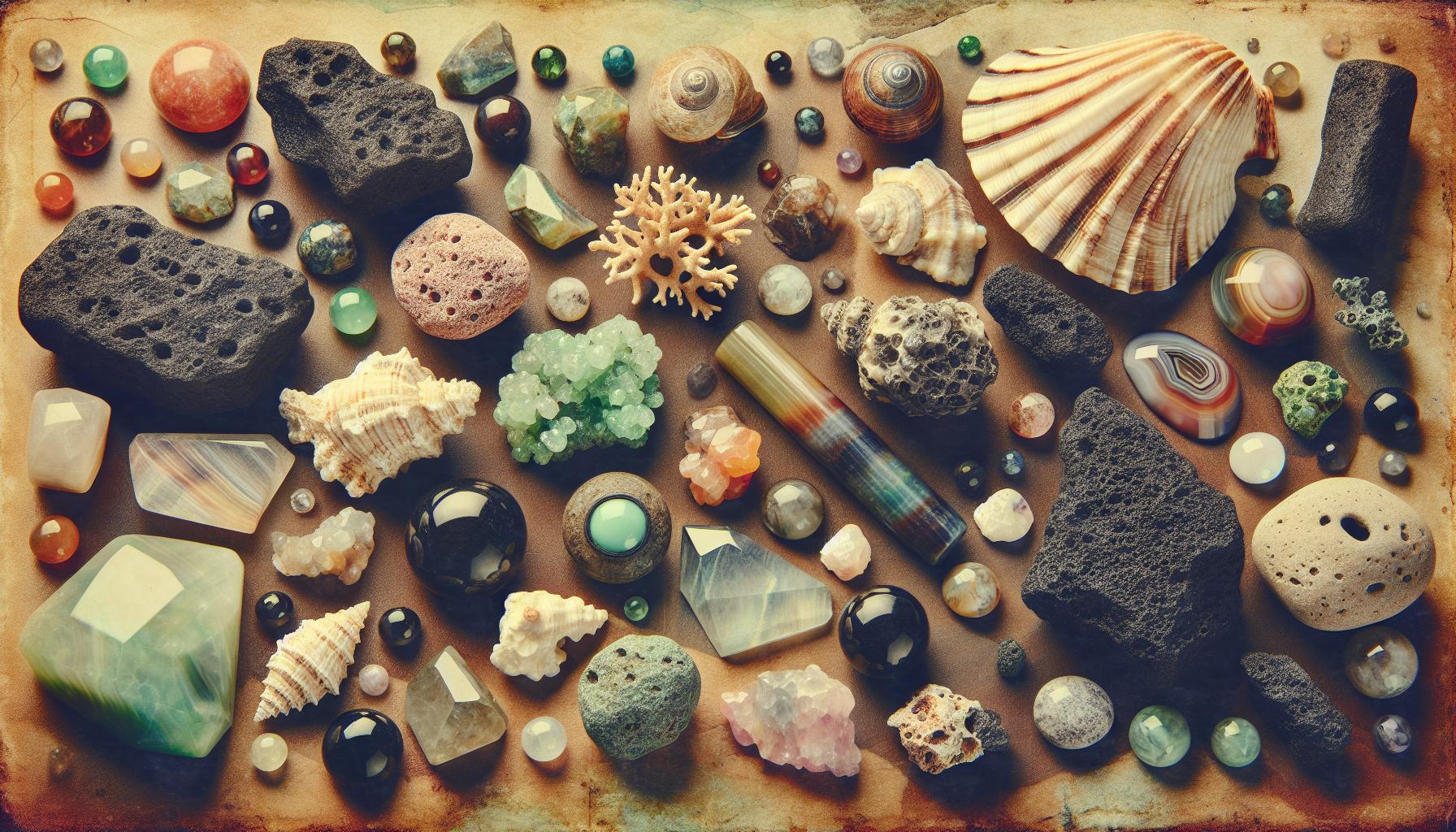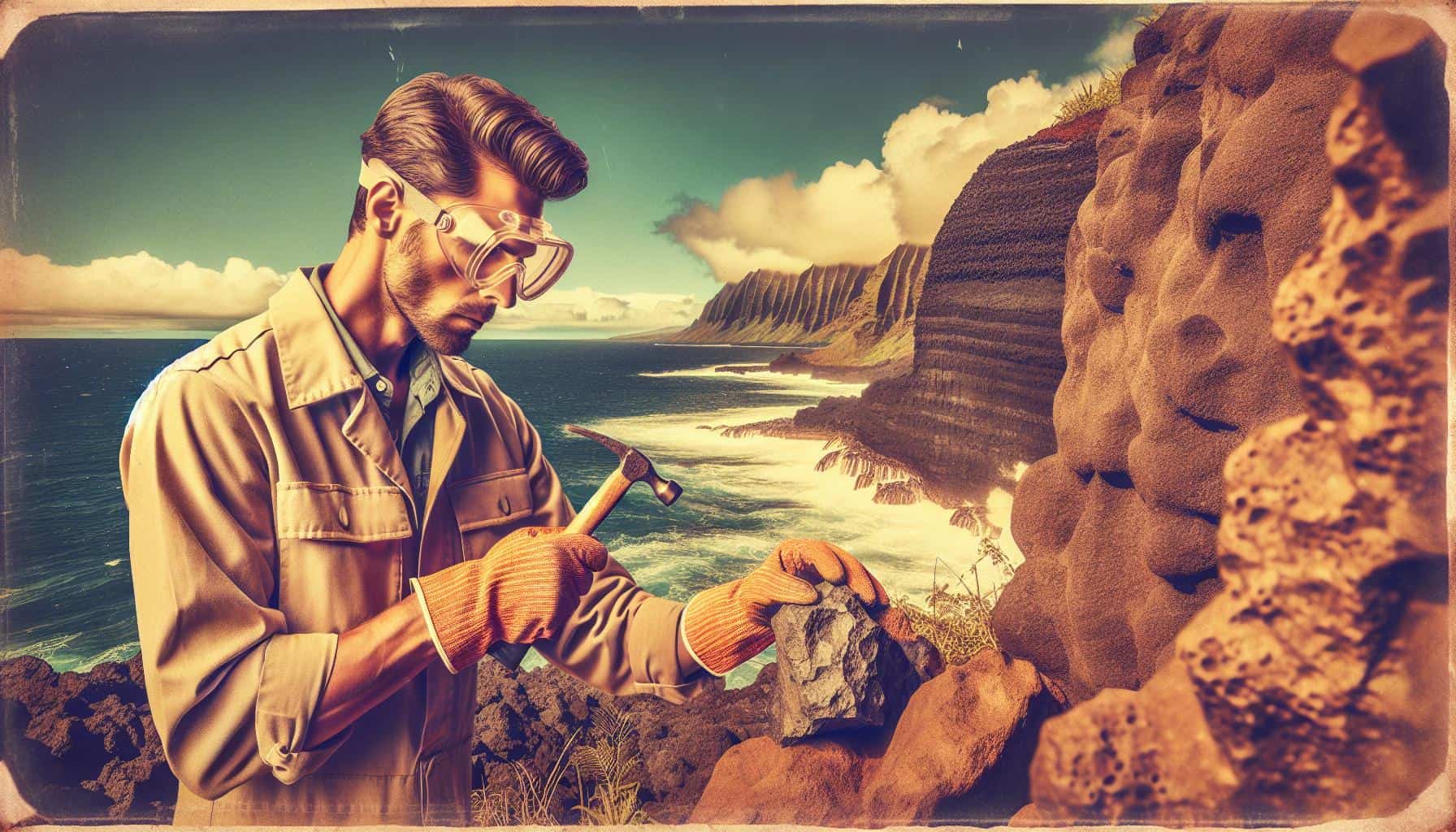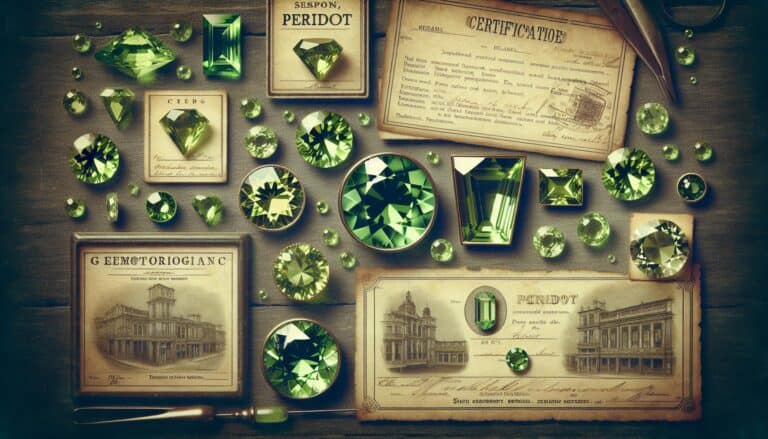Ready to uncover the hidden gems of Hawaii?
Your rockhounding adventure awaits on these volcanic islands, where the treasures of the earth are as diverse as the landscape itself. From the sun-kissed beaches to the lush, tropical forests, Hawaii offers a unique backdrop for your quest.
You’ll be amazed at what you can find: colorful agates, semiprecious stones, and even the famed volcanically-formed Hawaiian peridot. Each island has its own special spots where these natural wonders lie in wait.
So grab your gear, and let’s explore where to rockhound in Hawaii and the treasures you can expect to unearth.
Unleash your inner Indiana Jones and ethically discover Hawaii’s volcanic gems, diverse rocks, and ancient fossils with mindful exploration and local regulations in tow.
Hawaii Rockhounding Locations
Embarking on a rockhounding adventure in Hawaii takes you to some of the most scenic and geologically diverse spots in the Pacific. Each island boasts its own unique areas where you’re likely to find a treasure trove of volcanic gifts.
Oahu, known as “The Gathering Place,” isn’t just for surfers and beachgoers. Here, you’ll find spots like Makapu’u Point and Kahe Point. These locations offer glimpses of past volcanic activity and a chance to find world-renowned mineral specimens like the Hawaiian olivine, a gemstone better known locally as Peridot.
- Maui, the “Valley Isle,” provides rockhounds with the experience of exploring ancient lava flows and beaches. La Perouse Bay on Maui’s south shore is a hotspot for finding xenoliths, which are fragments of rock embedded in lava.
The Big Island of Hawaii doesn’t disappoint with its array of collecting sites. Green Sand Beach near South Point is enriched with olivine crystals, providing a distinct green hue to the sand. Moreover, the Kilauea Volcano offers access to fresh lava fields where various minerals can be extracted.
Adventurers in Kauai can’t miss Glass Beach, where years of smoothed sea glass make for an intriguing collector’s day out. Although less about minerals and more about unique beach glass, the location is still a must-visit for those interested in the unusual treasures shaped by nature’s forces.
| Island | Location | What You’ll Find |
|---|---|---|
| Oahu | Makapu’u Point | Hawaiian olivine (Peridot) |
| Oahu | Kahe Point | Mineral specimens |
| Maui | La Perouse Bay | Xenoliths |
| Hawaii (Big Is.) | Green Sand Beach | Olivine crystals |
| Hawaii (Big Is.) | Kilauea Volcano | Various minerals |
| Kauai | Glass Beach | Sea glass |
What Gemstones are Found in Hawaii?

Hawaii is not only a paradise for beach lovers and surfers but also a haven for rockhounders in search of gemstones. Hawaiian treasure troves include a variety of gems ranging from the rich green hues of peridot to the fiery brilliance of volcanic gems.
One of the most treasured finds in Hawaii is the Hawaiian Diamond, or peridot. This gemstone is actually the mineral olivine crystallized in lava rocks. Hawaii’s volcanoes provide an abundant source of peridot, turning the islands into one of the few places on Earth where you can find these gems in such natural settings.
Black Coral is another Hawaiian gem prized for its deep, mystical appearance and is considered a precious coral. Unlike other corals that are found in shallow waters, black coral thrives in deep sea environments. Harvesting of black coral is regulated, ensuring that your find is not only rare but also responsibly sourced.
If you’re looking for something truly unique, keep an eye out for Niihau Shells. These tiny shells come from the private island of Niihau and are incredibly rare. They are often used in creating exquisite, highly sought-after jewelry pieces.
Other stones found across the Hawaiian Islands include:
- Quartz varieties such as clear, smokey, and rose quartz
- Agates, with their telltale banded patterns
- Jasper, known for its earthy tones and durability
- Obsidian, formed from the rapid cooling of volcanic lava
While exploring Hawaii’s diverse regions, you might also stumble upon opalized coral and various fossilized materials which have been transformed into ornate stones over thousands of years.
What Sedimentary Rocks You Can Find in Hawaii?

While Hawaii is renowned for its volcanic rock formations, the island chain also offers a variety of sedimentary rocks that you can add to your collection. Sedimentary rocks, unlike the indigenous volcanic stones, tell a different story of Hawaii’s geological past.
Limestone is the most common sedimentary rock you’ll encounter in Hawaii. Formed from the skeletal fragments of marine organisms, limestone in Hawaii predominantly consists of coral and foraminifera. You can find high-quality samples of this sedimentary rock on the islands of Oahu and Maui, particularly near ancient reefs.
Sandstone is another sedimentary rock present in Hawaii although it’s less common than limestone. Hawaiian sandstone often displays beautiful hues due to the oxidation of iron within the layers. While it’s more challenging to locate, you’ll find exploring the larger islands like Hawaii’s Big Island for this sedimentary rock both rewarding and fascinating.
If you’re venturing into valleys and areas closer to the shore, you may stumble upon sedimentary conglomerate rocks. These rocks are formed by the cementing together of different-sized particles and can give insight into the powerful erosive forces that have shaped the island’s landscapes.
For those interested in unique finds, keep an eye out for Hawaiian beach rock. This sedimentary rock is formed from sand, coral fragments, and seashells binding together over time. Locations such as Kailua Beach Park and Waikiki often provide good opportunities to find beach rock specimens.
In addition to these, shale and mudstone can be uncovered, especially in areas where ancient lagoons once existed. Sites like the Ewa Plain on Oahu are known for these finer-grained sedimentary rocks due to the prehistoric environment that was conducive to their formation.
When searching for these sedimentary treasures, remember to respect the land and regulations in place. Always ensure you’re rockhounding legally and ethically, preserving Hawaii’s natural beauty for future generations.
What Metamorphic Rocks are found in Hawaii?
While Hawaii is renowned for its volcanic geological profile, you might be surprised to discover that the islands also boast a variety of metamorphic rocks. These rocks form under the immense pressure and heat conditions present deep within the Earth’s crust, which alters their mineral composition and structure.
Marble, which begins as limestone, can be found in certain parts of Hawaii. This rock is sought after for its exquisite appearance and is used in various decorative and architectural applications. Be on the lookout for this metamorphic rock in shades ranging from white to gray, often tinged with other hues depending on the minerals present.
Quartzite is another metamorphic treasure in the Hawaiian Islands, having originally been pure quartz sandstone before undergoing metamorphosis. This extremely hard rock resists weathering and can display a glassy sheen, making it a real find for rockhounders.
Arguably the most unique and rare of Hawaii’s natural metamorphic assortment is schist. With a characteristic flaky appearance, schist often contains visible crystals of mica, garnet, or other minerals that give it a sparkling, decorative aspect. When you’re exploring, areas where volcanic activity has historically occurred may give way to outcrops of this eye-catching rock.
Gneiss, with its distinctive banded patterns created by the segregation of mineral layers, forms the backbone of some Hawaiian localities. Its bands of light and dark minerals make it an interesting find, offering insight into the intense processes that shaped the land you stand on.
Keep in mind: rockhounding isn’t just about gathering; it’s about learning and appreciating. As you search for these metamorphic wonders, remember to handle all sites with care, adhere to local guidelines, and only take what you truly need. The natural heritage of Hawaii is to be respected so future generations can also revel in this geological playground.
What Igneous Rocks can You Find in Hawaii?
On your rockhounding journey through the Hawaiian Islands, you’ll encounter a diverse array of igneous rocks born from the fiery belly of the Earth. The islands themselves owe their existence to the hotspot volcanism that has created both intrusive and extrusive igneous specimens aplenty.
Basalt is the most common rock you’ll come across, forming the very ground beneath your feet. This dark, fine-grained rock is evidence of the rapid cooling of lava at the Earth’s surface and packs a variety of minerals such as olivine, pyroxene, and plagioclase feldspar. Look for its presence in the form of hexagonal columns at the Giants Causeway or as smooth pebbles on black sand beaches.
Another remarkable find is the obsidian, a natural volcanic glass, which occurs when lava with minimal water content cools rapidly. Its glassy luster and sharp edges have intrigued rockhounds for ages, but remember it’s rarely found across Hawaii and should be treasured when encountered.
For those interested in finding something extraordinarily unique, Hawaiian peridotite—a dense, coarse-grained igneous rock containing a high percentage of the mineral olivine—is worth seeking out. Although less common than basalt, it offers a fascinating glimpse into the composition of the Earth’s mantle.
- Scoria, resembling basalt but with a vesicular texture due to trapped gas bubbles, can also be found, particularly near volcanic vents.
- Pumice, another vesicular volcanic rock, often floats on water due to its high porosity and is a frequent sight after volcanic eruptions.
While exploring volcanic fields and old lava flows, you might also stumble upon andesite and rhyolite, two igneous rocks that, despite being less prevalent, provide insights into the complex volcanic history of the islands.
Remember to always carry your rockhound’s toolkit and adhere to the regulations of the areas you’re exploring. By doing so, you ensure that these geological treasures remain undisturbed and available for future generations of enthusiasts to discover and enjoy.
Panning for Gold in Hawaii
If you’ve been captivated by the prospect of panning for gold, Hawaii may not be the first place that springs to mind. Yet, the islands hold elusive secrets. Tucked within these tropical paradises are streams and rivers that carry small quantities of placer gold. Placer gold is derived from lodes that have eroded over time, releasing the valuable flakes into the waterways. While Hawaii isn’t known for massive gold rushes, patient prospectors can still enjoy the serene landscapes while seeking out these subtle treasures.
Your quest would lead you to the island of Hawaii, commonly referred to as the Big Island, where the most plausible opportunities lie. The streams flowing from the Mauna Kea and Mauna Loa volcanoes are your best bet. Years of volcanic activity have churned the earth, occasionally releasing mineralized particles that include gold.
Before setting out, you’ll need to be mindful of the regulations governing such activities. Obtaining Permission is essential as much of the land in Hawaii is privately owned or under state protection. It’s wise to consult with the Bureau of Land Management or the Hawaii Department of Land and Natural Resources to clarify where you can lawfully pan for gold.
In terms of equipment, simplicity is key. A basic gold panning kit with a sluice box, pan, and classifier is all that’s necessary for you to begin. Remember, panning is more about the experience and less about striking it rich. Many enthusiasts find joy in the subtle shimmer of gold specks caught in their pans alongside other minerals and gems native to Hawaii.
In your gold panning excursions across the Hawaiian Islands, expect to find colors ranging from bright yellow flakes to small, almost imperceptible particles. It’s an activity that takes you beyond the beaches and into the heart of Hawaii’s lush inland territories, inviting a deeper connection with the island’s geological makeup and its historic relationship with natural resources.
Rocks and Minerals Found in Hawaii
Rockhounding in Hawaii offers a unique opportunity to discover a rich variety of rocks and minerals that capture the islands’ volcanic history. Peridot remains one of the most abundant and famous rocks you’ll encounter. This gemstone is particularly striking due to its vibrant green color, which is especially vivid when found in lava rocks. It’s formed deep within the Earth’s mantle and brought to the surface by volcanic activity.
Obsidian, another volcanic glass, is frequently sought after by enthusiasts for its sharp edges and smooth finish. Hawaii provides the perfect environment for obsidian to form, with the rapid cooling of felsic lava creating these natural glasses. For those interested in semi-precious stones, Hawaii’s beaches and streams offer an array of quartz varieties, including clear, smoky, and rose quartz.
Agates and jasper can also be found, each with unique patterns and colors, making them perfect for collectors and hobbyists. The Big Island in particular is a hotspot for these finds. If you’re looking for fossils, certain areas in Hawaii have limestone formations holding marine fossils that tell tales of the ocean’s past inhabitants.
To simplify your search, here’s a table highlighting the notable rocks and minerals in Hawaii:
| Mineral | Location | Characteristics |
|---|---|---|
| Peridot | Volcanic Areas | Green Gemstone Found in Lava Rocks |
| Obsidian | Volcanic Areas | Natural Glass with Smooth Finish & Sharp Edges |
| Quartz | Beaches & Streams | Varieties include Clear, Smoky, and Rose |
| Agates | Big Island | Noted for Unique Patterns and Colors |
| Jasper | Big Island | Known for Rich Color Variations |
| Marine Fossils | Limestone Formations | Evidence of Ancient Marine Life |
While the lure of precious gems may draw you to Hawaii’s shores, it’s vital to remember that the islands are not just a treasure chest but also a delicate ecosystem. Local laws protect many of these natural wonders. Always familiarize yourself with the rules and seek the necessary permissions for collection.
Venturing into Hawaii’s diverse terrains, you’ll find that rockhounding is as much about appreciating the natural beauty and geological diversity as it is about the thrill of the hunt.
Where Can I Find Fossils in Hawaii?
Fossil hunting in Hawaii offers a journey into the islands’ ancient past. Marine fossils, primarily found in limestone and coral deposits, speak to an era when these volcanic islands were submerged beneath prehistoric seas. With a keen eye and a sense of adventure, you can discover oceanic relics that have been preserved for millennia.
One prime location for finding fossils is on the island of Oahu. At Shark’s Cove, within the Pūpūkea Marine Life Conservation District, you’ll find an abundance of marine fossils embedded in the rocks along the shoreline. The winter months occasionally unearth additional specimens due to the powerful ocean currents, so it’s an optimal time for your search.
Over on Maui, the Makawao Forest Reserve proves to be a rich hunting ground. As you wander along the trails, look for ancient sea snail fossils and fossilized corals that offer a glimpse into the marine life that once thrived here. It’s advisable to stay on marked paths to preserve the ecosystem while you explore.
The Big Island also harbors fossil opportunities, particularly along the Waikoloa Beach area. Here, amidst the black lava rock, fossilized coral and shells frequently emerge. It’s a testament to the Big Island’s dynamic geological history, showcasing a time when the ocean played a pivotal role in the shaping of its landscapes.
Remember, while your curiosity may be piqued, Hawaii’s fossils are precious and often part of the geological heritage. It’s crucial to respect local regulations. Do not remove any fossils from their natural settings without verifying the rules. Instead, photographing your finds can be a responsible way to document your discoveries.
It’s essential to arm yourself with a local guidebook or consult with experts at nearby nature centers which can provide in-depth knowledge about the types of fossils you might find and the best practices for responsible fossil hunting. This not only enhances your experience but ensures you’re contributing to the conservation efforts that maintain Hawaii’s natural beauty for future generations.
Hawaii Rockhounding Laws & Regulations
When you’re planning your rockhounding adventure in Hawaii, it’s crucial to familiarize yourself with the local laws and regulations. The islands have strict rules protecting natural resources, and violation can result in hefty fines or even criminal charges.
Rockhounding on public land requires discernment. Most public beaches and state parks in Hawaii do not allow the removal of sand, rocks, or other natural materials. To avoid legal complications, always check the specific rules of the area you’re visiting. On federal lands, such as national parks, rock collecting is usually prohibited. National forests may have different regulations, allowing the collection of small amounts for personal use, but commercial collecting is not permitted without a permit.
Private Property and collecting locations often have their own set of rules. Always get permission from the landowner before removing any rocks or minerals. Some sites may allow collecting for a fee or have specific restrictions on the types, sizes, or amounts of materials that can be taken.
- Respect all Cultural Sites: Disturbance or removal of materials from Hawaiian cultural sites is strictly forbidden.
- Adhere to the Endangered Species Act: Ensure your rockhounding activities don’t harm the habitats of endangered species.
When it comes to marine resources, aquatic rockhounding is also regulated. The coral reefs and marine life are protected, and collecting coral, whether living or dead, is generally prohibited.
To help maintain Hawaii’s natural beauty and ecosystem, always practice leave no trace principles. Take only photos and memories, and if you do collect, ensure it has minimal impact on the environment. Make sure to clean up after yourself, and don’t disturb wildlife or plant life. Remember, your commitment to responsible rockhounding ensures that these treasures will be available for generations to come.
Rockhounding Tips for Beginners in Hawaii
Gearing Up: Essential Tools for Rockhounding
When you’re setting out for a rockhounding adventure in Hawaii, it’s crucial to have the right gear. Proper tools can make the difference between a fruitful search and a frustrating day. At a minimum, you’ll want to pack:
- A sturdy backpack to carry your finds and tools
- A rock hammer for chipping away at geologic specimens
- Safety goggles to protect your eyes from flying rock chips
- Durable gloves to guard your hands against sharp edges
- A set of chisels and a pry bar for more precise work
- A magnifying glass to examine your treasures up close
- Buckets or bags for transporting your finds
Remember, while the excitement of uncovering hidden minerals is exhilarating, always prioritize the protection of natural sites.
Safety Tips While Rockhounding
Safety should be your top priority when rockhounding. Hawaii’s terrain can be treacherous with rugged landscapes and variable weather conditions. Keep these tips in mind to ensure your outings are safe and enjoyable:
- Always check the weather forecast before departing
- Wear sturdy boots that provide traction and ankle support
- Bring plenty of water, sunscreen, and a hat to guard against the sun
- Stay aware of your surroundings, especially in remote areas
- Let someone know your plans and expected return time
- Be mindful of the ocean’s proximity; tides can change rapidly
By being prepared, you’re not just looking out for your own safety, you’re also making sure you respect the natural habitat around you.
Legal Guidelines for Rockhounding Enthusiasts
Hawaii has specific laws and regulations that you must follow as a rockhound. Ignorance isn’t a viable excuse, and penalties for non-compliance can be severe. Here’s what you need to know:
- Obtain permission from landowners before entering and collecting on private land
- Be aware of designated conservation areas where collection is prohibited
- Understand the limits on public lands; national parks, state parks, and beaches often have strict no-collection policies
- Familiarize yourself with the Endangered Species Act to avoid disrupting protected habitats
- If you’re particularly keen on taking something home, consider visiting one of the authorized pay-to-dig sites
Staying informed and adhering to these guidelines shows your respect for Hawaii’s cultural and natural resources, ensuring that rockhounding can be enjoyed by generations to come.
Conclusion: Hawaii Rockhounding Guide & Map
Embarking on your Hawaiian rockhounding adventure means being prepared, safe, and respectful of the land and its laws.
With the right gear and a mindful approach, you’re set to discover the geological treasures that the islands have to offer. Remember, the experience isn’t just about what you find—it’s about the memories you create and the knowledge you gain. So grab your hammer and magnifying glass and set out to explore Hawaii’s rich earth.
Happy rockhounding!







